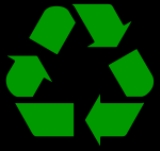
Recycling symbol
Encyclopedia

Unicode
Unicode is a computing industry standard for the consistent encoding, representation and handling of text expressed in most of the world's writing systems...
) is an internationally recognized symbol
Symbol
A symbol is something which represents an idea, a physical entity or a process but is distinct from it. The purpose of a symbol is to communicate meaning. For example, a red octagon may be a symbol for "STOP". On a map, a picture of a tent might represent a campsite. Numerals are symbols for...
used to designate recyclable
Recycling
Recycling is processing used materials into new products to prevent waste of potentially useful materials, reduce the consumption of fresh raw materials, reduce energy usage, reduce air pollution and water pollution by reducing the need for "conventional" waste disposal, and lower greenhouse...
materials. It is composed of three mutually chasing arrows that form a Möbius strip
Möbius strip
The Möbius strip or Möbius band is a surface with only one side and only one boundary component. The Möbius strip has the mathematical property of being non-orientable. It can be realized as a ruled surface...
(an unending single-sided looped surface).
In 1969 and early 1970, worldwide attention to environmental issues culminated in the first Earth Day
Earth Day
Earth Day is a day that is intended to inspire awareness and appreciation for the Earth's natural environment. The name and concept of Earth Day was allegedly pioneered by John McConnell in 1969 at a UNESCO Conference in San Francisco. The first Proclamation of Earth Day was by San Francisco, the...
. In response, then Chicago
Chicago
Chicago is the largest city in the US state of Illinois. With nearly 2.7 million residents, it is the most populous city in the Midwestern United States and the third most populous in the US, after New York City and Los Angeles...
-based Container Corporation of America
Container Corporation of America
Container Corporation of America was founded in 1926 and manufactures corrugated boxes. In 1968 CCA merged with Montgomery Ward & Company, Inc., in a move that was largely intended to thwart takeover bids against either company. MARCOR maintained separate management for the operations of each...
, a large producer of recycled paperboard which is now part of Smurfit-Stone Container
Smurfit-Stone Container
Financial Information 200720062005Total Revenue 7,4207,1576,812Smurfit-Stone Container Corporation was a global paperboard and paper-based packaging company based in Creve Coeur, Missouri, and Chicago, Illinois. It had approximately 21,000 employees...
, sponsored a contest for art and design students at high schools and colleges across the country to raise awareness of environmental issues. It was won by Gary Anderson
Gary Anderson (Recycling)
Gary Dean Anderson is an influential graphic designer and architect. He is most well known as the designer of the recycling symbol, one of the most readily recognisable logos in the world....
, a 23-year-old college student at the University of Southern California
University of Southern California
The University of Southern California is a private, not-for-profit, nonsectarian, research university located in Los Angeles, California, United States. USC was founded in 1880, making it California's oldest private research university...
, whose entry was the image now known as the universal recycling symbol.
Variants
The recycling symbol is in the public domainPublic domain
Works are in the public domain if the intellectual property rights have expired, if the intellectual property rights are forfeited, or if they are not covered by intellectual property rights at all...
, and is not a trademark
Trademark
A trademark, trade mark, or trade-mark is a distinctive sign or indicator used by an individual, business organization, or other legal entity to identify that the products or services to consumers with which the trademark appears originate from a unique source, and to distinguish its products or...
. The Container Corporation of America originally applied for a trademark on the design, but the application was challenged, and the corporation decided to abandon the claim. As such, any one may use or modify the recycling symbol, royalty free.
Though use of the symbol is regulated by law in some countries, countless variants of it exist worldwide. Anderson's original proposal had the arrows form a triangle standing on its tip — upside down compared with the versions most commonly seen today — but the CCA, in adopting Anderson's design, rotated it 60° to stand on its base instead.
Both Anderson's proposal and CCA's designs form a Möbius strip with one half-twist by having two of the arrows fold over each other, and one fold under, thereby canceling out one of the other folds. However, most variants of the symbol used today have all the arrows folding over themselves, producing a Möbius strip with three half-twists. Existing single half-twist variants of the logo do not generally agree on which of the arrows is the one to fold underneath. The logo is usually displayed with the arrows circulating clockwise, but the underlying Möbius strip exists in two topologically
Topology
Topology is a major area of mathematics concerned with properties that are preserved under continuous deformations of objects, such as deformations that involve stretching, but no tearing or gluing...
distinct mirror-image forms of opposite handedness
Handedness
Handedness is a human attribute defined by unequal distribution of fine motor skills between the left and right hands. An individual who is more dexterous with the right hand is called right-handed and one who is more skilled with the left is said to be left-handed...
.
The American Paper Institute originally promoted four different variants of the recycling symbol for different purposes. The plain Möbius loop, either white with an outline or solid black, was to be used to indicate that a product was recyclable. The other two variants had the Möbius loop inside a circle — either white on black or black on white — and were meant for products made of recycled materials, with the white-on-black version to be used for 100% recycled fiber, and the black-on-white version for products containing both recycled and unrecycled fiber. For example, a paper envelope might have both the first and last of these four symbols, to indicate that it was recyclable, and made from both recycled and unrecycled fibers.
An ISO/IEC working group has researched and documented some of the variations of the recycling logo currently in use, and has made recommendations for adding some more of them to the Unicode standard
Resin identification code
In 1988, the American Society of the Plastics IndustrySociety of the Plastics Industry
Founded in 1937, The Society of the Plastics Industry, Inc. is the trade association representing one of the largest manufacturing industries in the United States. SPIs members represent the entire plastics industry supply chain in the US, including processors, machinery and equipment manufacturers...
(SPI) developed the resin identification code
Resin identification code
The SPI resin identification coding system is a set of symbols placed on plastics to identify the polymer type. It was developed by the Society of the Plastics Industry in 1988, and is used internationally....
which is used to indicate the predominant plastic material used in the manufacture of the product or packaging. Their purpose is to assist recyclers with sorting the collected materials, but they do not necessarily mean that the product/packaging can be recycled either through domestic curbside collection or industrial collections. The SPI symbols are loosely based on the Möbius loop symbol, but feature simpler bent (rather than folded over) arrows that can be embossed on plastic surfaces without loss of detail. The arrows are formed into a flat, two-dimensional triangle rather than the pseudo three-dimensional triangle used in the original recycling logo.
The different resin identification codes can be represented by Unicode
Unicode
Unicode is a computing industry standard for the consistent encoding, representation and handling of text expressed in most of the world's writing systems...
icons (U+2673), (U+2674), (U+2675), (U+2676), (U+2677), (U+2678), (U+2679), and (U+267A).
Other variants

Infinity
Infinity is a concept in many fields, most predominantly mathematics and physics, that refers to a quantity without bound or end. People have developed various ideas throughout history about the nature of infinity...
sign (∞) inside a circle represents the permanent paper symbol, used in packaging and publishing to signify the use of durable acid-free paper
Acid-free paper
Acid-free paper is paper that has a neutral or basic pH . It can be made from any cellulose fiber as long as the active acid pulp is eliminated during processing. It is also lignin and sulfur free...
. In some ways, this logo expresses the opposite intention from the recycle logo, in that the acid-free paper is intended to last indefinitely, rather than being recycled. Nevertheless, acid-free paper does not usually contain toxic materials (although certain inks do), so it is easily recycled or composted.
A satirical version of the classic recycling logo also exists, in which the three arrows are twisted from a circular pattern to pointing radially outward, thus symbolizing wasteful one-time usage rather than environmentally friendly recycling. This message is reinforced by the circular inscription, "THIS PROJECT WAS ENVIRONMENTALLY UNFRIENDLY", surrounding the modified logo. The satirical logo appears in the 1998 catalog of an installation art
Installation art
Installation art describes an artistic genre of three-dimensional works that are often site-specific and designed to transform the perception of a space. Generally, the term is applied to interior spaces, whereas exterior interventions are often called Land art; however, the boundaries between...
work in Bayonne, New Jersey
Bayonne, New Jersey
Bayonne is a city in Hudson County, New Jersey, United States. Located in the Gateway Region, Bayonne is a peninsula that is situated between Newark Bay to the west, the Kill van Kull to the south, and New York Bay to the east...
, in which the artist Steven Pippin
Steven Pippin
Steven Pippin is an English artist. Pippin works with converted or improvised photographic equipment and kinetic sculptures....
modified a row of glass-doored washing machines in a laundromat to operate as giant cameras. The cameras were used to take sequential photographs in the manner of pioneering stop-motion photographer Eadweard Muybridge
Eadweard Muybridge
Eadweard J. Muybridge was an English photographer who spent much of his life in the United States. He is known for his pioneering work on animal locomotion which used multiple cameras to capture motion, and his zoopraxiscope, a device for projecting motion pictures that pre-dated the flexible...
. The front-loading washing machines were then used to develop and process the 24 inch (61 cm) diameter circular film negatives. For technical reasons, the processing of the film was very inefficient in its use of photographic chemicals, perhaps prompting the use of the ironic logo. It is not known whether this particular variant of the recycling logo was used prior to or subsequently to its appearance in the art catalog.
See also
- Green Dot symbol
- List of international common standards
- International Universal Recycling CodesInternational Universal Recycling CodesRecycling codes are used to identify the material from which an item is made, to facilitate easier recycling or other reprocessing. Such symbols have been defined for batteries, biomatter/organic material, glass, metals, paper, and plastics.-See also:...
- Japanese recycling symbolsJapanese recycling symbolsJapan has a system of recycling marks, , which indicate and classify recyclable materials.They are similar to the resin identification codes, in that they have surrounding arrows, with text inside to indicate the type of material....
- Resin identification codeResin identification codeThe SPI resin identification coding system is a set of symbols placed on plastics to identify the polymer type. It was developed by the Society of the Plastics Industry in 1988, and is used internationally....
- SPI resin identification coding system (NA Society of the Plastics Industry) for classifying different recyclable plastics.

